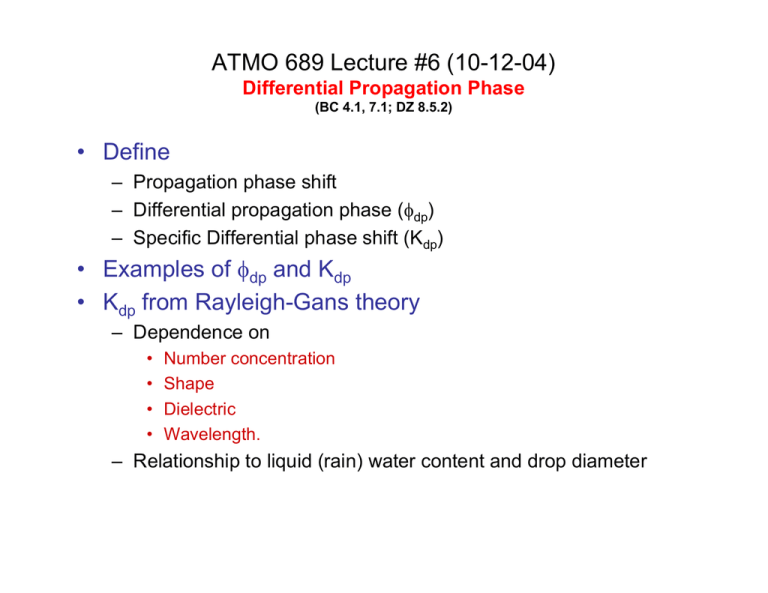Differential Propagation Phase
advertisement

ATMO 689 Lecture #6 (10-12-04)
Differential Propagation Phase
(BC 4.1, 7.1; DZ 8.5.2)
• Define
– Propagation phase shift
– Differential propagation phase (φdp)
– Specific Differential phase shift (Kdp)
• Examples of φdp and Kdp
• Kdp from Rayleigh-Gans theory
– Dependence on
•
•
•
•
Number concentration
Shape
Dielectric
Wavelength.
– Relationship to liquid (rain) water content and drop diameter
Differential Propagation Phase (ΦDP) and Specific Differential Phase (KDP)
P
Transmitted
Forward Scattered
Net (shifted Φ)
As a transmitted radar wave of a given polarization interacts with a
medium containing oriented non-spherical hydrometeors (e.g.,
raindrops), the resultant wave at some point “P” is phase shifted.
This phase shifted “effective” wave is due to a superposition of both
the forward scattered and transmitted wave phases (which have
different origins and hence different phase angles).
The shift in phase is referred to as the “propagation phase
shift”- Φ
Effect of polarization: The phase of the forward scatter component depends on the wave
polarization therefore, we expect the propagation phase shift (Φ) to vary as a function of
polarization (e.g., horizontal, H, and vertical, V).
Define differential propagation phase (ΦDP)* - difference between ΦH and ΦV :
ΦDP = [ΦH – ΦV]
* Sometimes called the “differential propagation phase shift”
Phase Cont……….
• Rain drops are typically oblate and hence the “electrical
size” is larger in the horizontal plane.
rain drop
H
V
• This means the phase speed of the horizontally polarized
wave is slowed relative to that of the vertical wave during
wave-drop interaction. Result is that ΦH > ΦV and hence
ΦDP > 0
What would a negative ΦDP imply and what type of particles
could cause this?
Since ΦDP is range cumulative, it makes sense to define a spatially “local” differential
phase shift in order to discern structure in the scattering medium (e.g., heavy rain cores).
Hence we define the specific differential phase (KDP) for Rayleigh conditions:
KDP
∂ΨDP*
∂ΦDP
(degrees/km)
=½
= ½ ∂r
∂r
Factor of ½ accounts
for two-way propagation
* Recall that ΨDP = δ + ΦDP
ΨDP is what is actually measured.
For Rayleigh conditions, δ is
small, so ΨDP = ΦDP
For future reference: in relation to calculation of KDP, note
that ΨDP is typically measured to an accuracy of 2-3o.
Example of Differential Propagation Phase (φdp) and
Specific Differential Phase (Kdp) in rain at C-band (5.5 cm)
Zh (dBZ, contoured)
Zh (dBZ)
φdp (deg)
Zdr (dB, shaded)
Ψdp (deg, dash-dot)
φdp (deg, dark solid)
δ (deg, light solid)
Kdp (deg/km, dot)
Carey et al. (2000)
KDP Cont……
More formally: (coherent propagation through a volume particles; BC Sec. 4.1, 7.1)
KDP = { 2π/k } ∫ N(D) Re [h·f(r,D) - v·f(r,D)] dD
0
f = forward scattering phase function
(1)
N(D) = particle size distribution; k0 = free space propagation constant (intrinsic wave number)
(h) and (v) are unit vectors along the H and V axis, and (r) is the particle axis ratio (e.g.,
a/b). D is particle diameter (i.e., equivalent spherical).
To see the “electrical size” dependence for KDP, assume the special case of a uniform size
distribution of concentration N (m-3) oblate (or prolate) spheroids. In this case (BC Sec. 4.1):
k 02
α
α= polarizability
h·f =
4πε0
2
αZb = polarizability along the
v·f = k0 αzb
particle symmetry axis
4πε
0
and
KDP =
103nk0
2ε0
α - αzb > 0, KDP > 0;
More interaction with particle in H
direction- phase speed slower in H
(α – αzb)
α – αzb < 0, KDP < 0
More interaction with particle in V
direction- phase speed slower in V
KDP Cont……
KDP = { 2π/k } ∫ N(D) Re [h·f(r,D) - v·f(r,D)] dD
0
Now, under Rayleigh-Gans
λz= a geometric/shape term
conditions (1) becomes:
dependent on axis ratio and
πk
0/12 } ∫ D3N(D) F(r,εr) dD eccentricity (similar to P term that
KDP = {
(2)
where F(r,εr) =
εr-1
εr-1
1+½(1-λz) (εr-1)
1+λz(εr-1)
we introduced in ZDR discussion;
λz defined in BC Appendix 1)
• Recall that k0 = 2π/λ, where λ = wavelength, hence we immediately see a wavelength
(frequency) dependence in KDP. Shorter wavelengths will be more sensitive (e.g.,
measure larger KDP for the same particle volume) than longer wavelengths by a factor of
λlong
/λshort.
• Since KDP is integrated over the product of the DSD (includes number conc.) weighted
by D3 and a function of axis ratio, KDP is sensitive to both the number of particles and
their shape (e.g., content and shape).
• Compare to ZDR - independent of both number concentration and drop volume.
• The combined content and shape sensitivity of KDP can be clearly seen if F(r,εr) is
evaluated by either empirical methods or mathematical manipulation. Ultimately, the result
for microwave frequencies (3-30 GHz) is:
(3)
Re [h·f(r,D) - v·f(r,D)] = F(r, εr) ≈ C (1-a/b) = C(1-r)
3.3 ≤ C ≤ 4.2 for 0.5 ≤ r ≤ 1
KDP Cont……
Now if we substitute (3) into (2) we get:
KDP = { Cπk0/12} ∫ D3N(D) (1-r) dD
which can be written as:
KDP = { Cπ/λρ } ∫ π/6 ρw D3 (1-r) N(D) dD
w
KDP = { Cπ/λρ } [ ∫ π/6 ρw D3 N(D) dD - ∫ π/6 ρw D3r N(D) dD ]
w
Liquid water content (W)
= mass-weighted mean
axis ratio (rm)
KDP = { CπW/λρ } 1 - ∫ π/6 ρw D3r N(D) dD
w
∫ π/6 ρw D3 N(D) dD
KDP = { 180/λ} 10-3 C W (1- rm)
W= g/m3
(o / km)
λ= m;
C=3.75 (independent of
wavelength)
• KDP proportional to product of liquid water content and mass-weighted mean axis ratio.
• KDP can be non-zero even in the presence of small drops
• Now Use Pruppacher and Beard (1970) D-r relationship with r=rm and D=Dm (mm)
KDP = { 180/λ} 10-3 C W (.062Dm) Dm (mm), W (g/m3), λ (m), KDP (o / km)
KDP Cont……
x
C
S
Computations (Fig. 7.7 BC) using
T-matrix reveal the approximately
linear change of KDP/W with Dm, as
expected from Rayleigh-Gans
approximation. This turns out to
be valid for frequencies from 3-13
GHz.
• For KDP, we have that KDP ∝ WDm and for equilibrium shapes based on Pruppacher
and Beard (1970), rm = 1-γDm. Hence, WDm ∝ 1/γ KDP. So, any change in the
slope relationship for r vs. D will influence our diagnosis of WDm via KDP
measurements (this will become an important issue for rainfall and attenuation
relationships using KDP later.)

